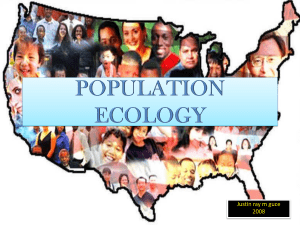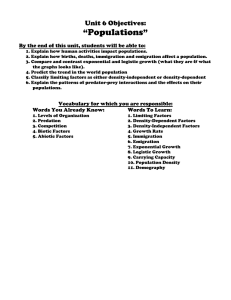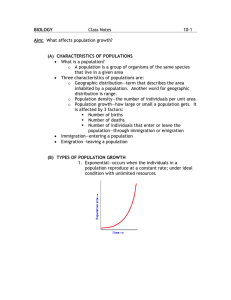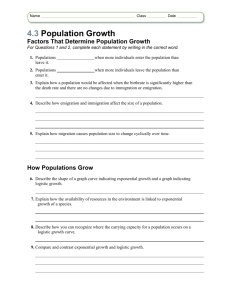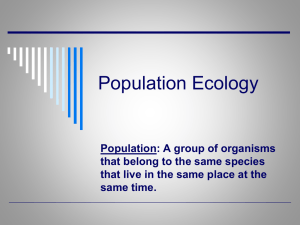Population Biology: Growth, Density & Limiting Factors
advertisement
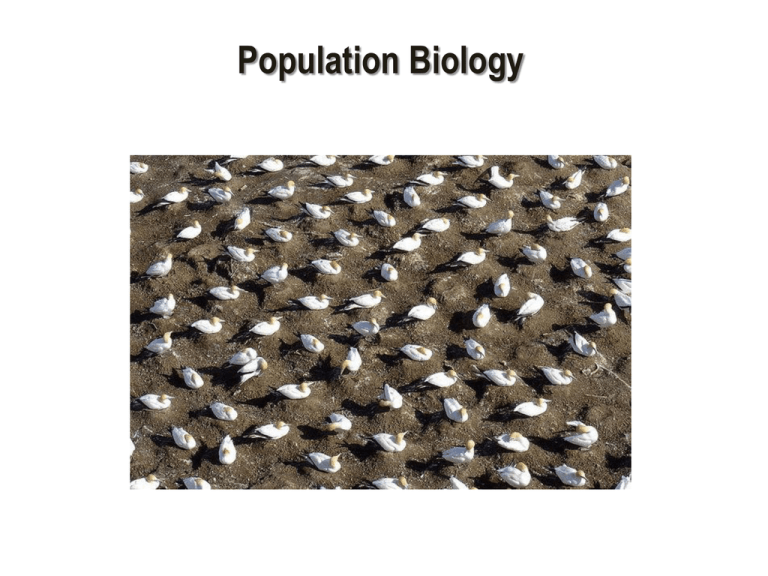
Population Biology How Study Populations? Geographic Range Density and Distribution Growth rate Age structure Geographic Range • The area inhabited by a population • Can vary greatly depending on the species (bacteria on a rotting pumpkin vs. cod in the western Atlantic ocean from Greenland to North Carolina Density and Distribution • Population density refers to the number of individuals per unit area • Distribution refers to how individuals in a population are spaced out across the range of the population: random, uniform or clumps. Random Uniform Clumped Growth Rate • Determines whether the size of the population increases, decreases, or stays the same. can be positive, negative or zero Age Structure • The number of males and females of each age a population contains • Important because most animals do not reproduce until a certain age Population Growth Factors that effect population growth 1. Birth Rate and Death Rate In a given period of time: • Birth rate > death rate population increases • Birth rate = death rate population stays the same • Birth rate < death rate population decreases 2. Emigration and Immigration • Immigration – movement of individuals into an area occupied by an existing populations • Emigration – movement of individuals out of an area Exponential vs. Logistic Growth Would you take the money? Exponential Growth • Under ideal conditions with UNLIMITED resources, a population can and will grow exponentially. • Exponential growth is when a population increases exponentially Xn (often doubling) Logistic Growth • Resources are NOT unlimited so a population can not grow exponentially forever • Logistic growth occurs when a populations’ growth slows and then stops, following a period of exponential growth Carrying Capacity The maximum number of individuals of a particular species in a particular environment can support (without degrading it for future generations) * Population will hover around the CC Limiting Factors A factor that controls the growth of a population Examples: Competition Predation Parasitism and disease Weather Natural Disaster Nutrients Acting separately or together, limiting factors determine the carrying capacity of an environment for a species Limiting factors are either Density Dependent or Density Independent Density Dependent Factor operate strongly when population density (number of organisms per unit area) reaches a certain level. Examples Include: 1. Competition - overcrowding lead to competition over essential resources….there more there are, the sooner they use up the resources 2. Predation and Herbivory – Predator population increases, prey decreases and vice versa. Think of herbivores as “predators” of plants 3. Parasitism and Disease– The more organisms in a given area, the easier it is to spread disease 4. Stress from overcrowding – organisms can fight within species if too crowded, and cause females to neglect or kill their young, decrease birth rates, and increase emigration and death rates Density Independent Factor affect all populations in similar ways, regardless of population size and density. Examples Include: Weather, hurricanes, droughts, floods wildfires, etc. However, some of these independent factors work with density. Example: Isle Royale (Moose & cold winter)

